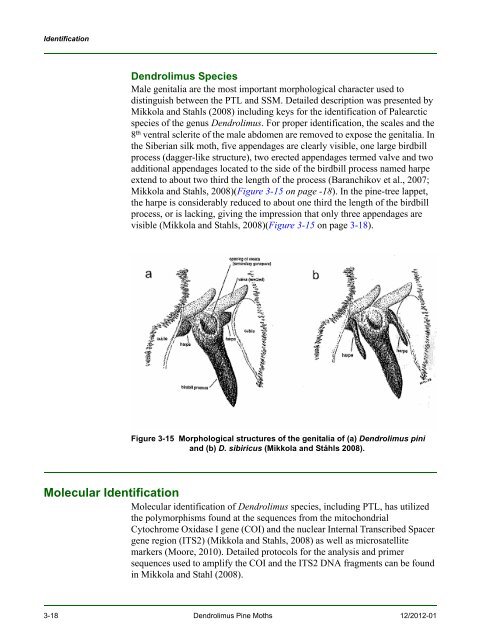New Pest Response Guidelines - aphis - US Department of Agriculture
New Pest Response Guidelines - aphis - US Department of Agriculture
New Pest Response Guidelines - aphis - US Department of Agriculture
You also want an ePaper? Increase the reach of your titles
YUMPU automatically turns print PDFs into web optimized ePapers that Google loves.
Identification<br />
Dendrolimus Species<br />
Male genitalia are the most important morphological character used to<br />
distinguish between the PTL and SSM. Detailed description was presented by<br />
Mikkola and Stahls (2008) including keys for the identification <strong>of</strong> Palearctic<br />
species <strong>of</strong> the genus Dendrolimus. For proper identification, the scales and the<br />
8 th ventral sclerite <strong>of</strong> the male abdomen are removed to expose the genitalia. In<br />
the Siberian silk moth, five appendages are clearly visible, one large birdbill<br />
process (dagger-like structure), two erected appendages termed valve and two<br />
additional appendages located to the side <strong>of</strong> the birdbill process named harpe<br />
extend to about two third the length <strong>of</strong> the process (Baranchikov et al., 2007;<br />
Mikkola and Stahls, 2008)(Figure 3-15 on page -18). In the pine-tree lappet,<br />
the harpe is considerably reduced to about one third the length <strong>of</strong> the birdbill<br />
process, or is lacking, giving the impression that only three appendages are<br />
visible (Mikkola and Stahls, 2008)(Figure 3-15 on page 3-18).<br />
Figure 3-15 Morphological structures <strong>of</strong> the genitalia <strong>of</strong> (a) Dendrolimus pini<br />
and (b) D. sibiricus (Mikkola and Ståhls 2008).<br />
Molecular Identification<br />
Molecular identification <strong>of</strong> Dendrolimus species, including PTL, has utilized<br />
the polymorphisms found at the sequences from the mitochondrial<br />
Cytochrome Oxidase I gene (COI) and the nuclear Internal Transcribed Spacer<br />
gene region (ITS2) (Mikkola and Stahls, 2008) as well as microsatellite<br />
markers (Moore, 2010). Detailed protocols for the analysis and primer<br />
sequences used to amplify the COI and the ITS2 DNA fragments can be found<br />
in Mikkola and Stahl (2008).<br />
3-18 Dendrolimus Pine Moths 12/2012-01

















